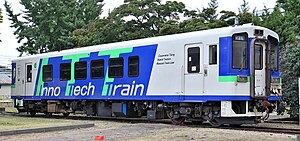KiHa 160
| KiHa 160 | |
|---|---|
 KiHa 160-1 as the "Inno Tech Train" in September 2010 | |
| In service | 1 June 1997 – 2013 |
| Manufacturer | Niigata Tekko |
| Constructed | 1997 |
| Refurbished | 2007 |
| Scrapped | 2013 |
| Number built | 1 vehicle |
| Number in service | None |
| Formation | Single car |
| Fleet numbers | KiHa 160-1 |
| Capacity | 110 (42 seated) |
| Operators | JR Hokkaido |
| Depots | Tomakomai |
| Lines served | Hidaka Main Line |
| Specifications | |
| Car body construction | Steel |
| Car length | 18,500 mm (60 ft 8 in) |
| Width | 2,700 mm (8 ft 10 in) |
| Height | 3,620 mm (11 ft 11 in) |
| Doors | 2 sliding doors per side |
| Maximum speed | 110 km/h (70 mph) |
| Weight | 32.5 t |
| Prime mover(s) | N-DMF13HZ |
| Power output | 330 hp (250 kW) |
| Transmission | Hydraulic |
| Bogies | N-DT150 (motored), N-TR150 (trailer) |
| Multiple working | KiHa 130 |
| Track gauge | 1,067 mm (3 ft 6 in) |
The KiHa 160 (キハ160形) was a single-car diesel multiple unit (DMU) train operated by Hokkaido Railway Company (JR Hokkaido) on the Hidaka Main Line in Japan. A single car was built in 1997 by Niigata Tekko (now Niigata Transys) to replace the KiHa 130 DMU car (KiHa 130-5) withdrawn due to collision damage sustained in a level crossing accident in January 1996.[1] From 2007, the unit was rebuilt as an experimental hybrid car, branded "Inno Tech Train", before being finally withdrawn in fiscal 2013.
Design
The design was based on the Tsugaru Railway 21 series DMU built to Niigata's "NDC" lightweight design.[2] As with the KiHa 150-100 cars, the Kiha 160 had inward-opening hopper windows.[3]
When delivered, the unit was originally painted in a similar livery to the KiHa 150-0 units, with light green doors, a light green waistline band, and light purple stripes.[4] From September 1999, it was repainted into a new livery similar to the KiHa 40-350 DMUs transferred to the Hidaka Line on which the KiHa 160 was used.[2]
Internally, the car had fixed 2+1 facing transverse seating bays, with longitudinal bench seating next to the doorways.[3]
-
 A JR Hokkaido KiHa 150-100 series DMU car in September 2008, showing the same livery as initially carried by Kiha 160-1
A JR Hokkaido KiHa 150-100 series DMU car in September 2008, showing the same livery as initially carried by Kiha 160-1 -
 KiHa 160-1 at Tomakomai Station in revised livery before rebuilding
KiHa 160-1 at Tomakomai Station in revised livery before rebuilding
History
KiHa 160-1 entered revenue service on the Hidaka Main Line on 1 June 1997, used interchangeably with the KiHa 130 DMUs also used on the line.[3]
In 2007, the unit was rebuilt as an experimental hybrid vehicle using a motor-assisted hybrid system. At the same time, the longitudinal bench seating was replaced with limited-express style transverse seating.[2]
Following the completion of testing, the unit was placed in storage at Naebo Works,[2] before being officially withdrawn in fiscal 2013.[5]
References
- ^ Jēāru zensharyō handobukku: Rail Magazine 2009 JR全車輌ハンドブック2009 [JR Rolling Stock Handbook 2009]. Japan: Neko Publishing. 2009. p. 473. ISBN 978-4-7770-0836-0.
- ^ a b c d Nishiwaki, Kōji (October 2011). JR各社の新世代気動車の現状 JR北海道キハ160形 JR東日本キハE200形 [The Current Situation of JR Group Modern DMUs: JR Hokkaido KiHa 160 & JR East KiHa E200]. Japan Railfan Magazine. Vol. 51, no. 606. Japan: Koyusha Co., Ltd. pp. 96–101.
- ^ a b c 日本と世界の鉄道カタログ'97~'98 [Japan and World Railway Catalogue 1997–1998] (in Japanese). Japan: Seibido Publishing. 17 August 1997. pp. 58–59. ISBN 978-4-415-09254-6.
- ^ JR全車輛ハンドブック1997 [JR Rolling Stock Handbook 1997]. Japan: Neko Publishing. 1997. p. 360.
- ^ Tezuka, Kazuyuki (July 2014). 車両のうごき2013-2014 [Rolling stock changes (2013–2014)]. Japan Railfan Magazine (in Japanese). Vol. 54, no. 639. Japan: Koyusha Co., Ltd. p. 70.
External links

- JR Hokkaido KiHa 160 (Japan Railfan Magazine) (in Japanese)














